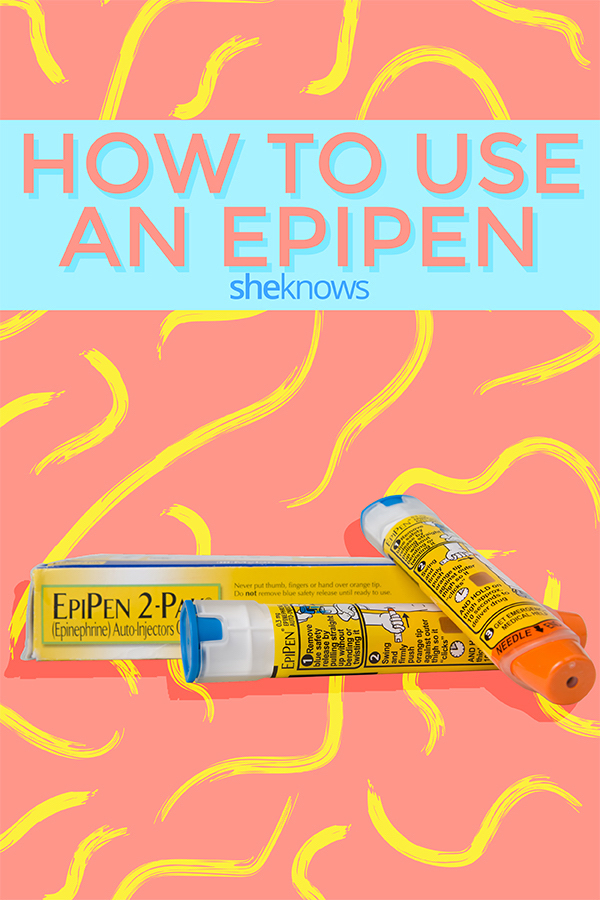If you (or someone you love) experience a severe allergic reaction, do you know what to do? If you’ve already been through the diagnostic process and have an EpiPen on hand, do you know how to use it? Let’s take a look at how EpiPens work, when to use them and perhaps most important, how to use them correctly.
What is an EpiPen, anyway?
We spoke with Tonya Winders, CEO and president of the Allergy & Asthma Network, and Dr. Purvi Parikh, an allergist and immunologist with Allergy & Asthma Network, to get the lowdown on severe allergies and how EpiPens work.
First, let’s look at the pen itself. An EpiPen is a device patients can use to inject themselves with epinephrine, also known as adrenaline. It allows the user (or a caregiver) to easily administer the drug without having to worry about drawing medication into a syringe and determining the proper dosage, which is ideal in emergency situations when time is of the essence.
More: Semen Allergies Are Real & Make It Harder to Conceive
How does the drug itself work? Winders says, “When a person has a life-threatening allergic reaction, epinephrine reverses the symptoms by constricting blood vessels to return the blood pressure to a normal state and increasing the heart rate to improve blood flow. Breathing is often affected, and adrenaline relaxes the muscles of the person’s airway, allowing them to breathe more easily.”
When do you use one?
Parikh notes that there are a few symptoms that should trigger EpiPen use: any skin symptom, such as hives, itching and/or swelling, plus vomiting, dizziness, wheezing or shortness of breath. This is known as anaphylaxis and is always a medical emergency. If left untreated, it may result in death.
However, if you’re not sure, it may be best to go ahead and use it. “When in doubt, we always recommend to use the EpiPen, as the harm of delay in using [it] is far worse than accidentally injecting the medicine when not needed,” she explains.
The most common cause of anaphylaxis is food allergies. Other common causes of anaphylaxis include insect stings and medication. However, Parikh warns that any allergy can lead to anaphylaxis if the reaction is severe enough.
More: Is It True Your Allergies Change Every 7 Years?
How do you use one?
For starters, every EpiPen has instructions printed right on the device itself, and every box comes with a trainer — this allows you to practice without actually stabbing yourself in the thigh (it makes a loud “click” but no needle shoots out). That being said, here are some step-by-step instructions from Winders (do keep in mind that there are other epinephrine auto-injectors available, so always read and carefully follow those instructions to the letter).
- Remove the auto-injector from its protective case. Check to make sure the expiration date has not passed and the liquid inside looks clear.
- Follow the instructions to remove the safety cap(s). Keep your hand and fingers away from the needle end.
- Hold the injector in your fist with the needle end (usually red or orange) away from your thumb, and place the needle end firmly against the outer thigh (the upper leg). Do not inject into the buttocks or elsewhere on the body. The needle is designed to go through clothing if necessary.
- Press firmly to release the needle and inject the epinephrine into the outer thigh. Hold the leg and keep it steady while you inject the epinephrine.
- Once injected, follow the device instructions on how long to keep it in place — usually several seconds — until all the epinephrine is delivered.
- Remove the device and massage the injection site for 10 seconds.
- Some injectors have a needle that retracts back into the case after use; others leave the needle exposed. If the needle remains exposed, carefully insert the injector — needle first — back into the carrying case. Don’t be concerned if you see liquid left in the device; it is designed to release the proper dose correctly.
- Never try to reinject yourself with the same pen.
- Call 911 immediately. Tell the dispatcher you just used epinephrine to treat a suspected anaphylactic reaction. Make arrangements for transport to an emergency department for additional treatment.
- Do not dispose of the auto-injector yourself. Give it to the emergency care team and tell them where it was injected.
What happens if it’s not used correctly?
It’s crucial that an EpiPen is used correctly. Winders says, “Epinephrine is a lifesaving medication. If it either is not delivered or an inadequate dose is administered, it can’t help the patient.” Since anaphylaxis can and does lead to death, proper usage is essential.
More: Are Your Cold Symptoms Actually Allergies?
While recent reports from the FDA show that there has been a rising incidence of mechanical failure on the part of the EpiPen itself, these episodes are extremely rare.
“While we’ve been talking device failures, this is a lifesaving medication, and the device is reliable with very few exceptions,” says Winders. “It is still very important for patients who are at risk of anaphylaxis [to] carry their auto-injector with them at all times.”
While nobody wants to experience a severe allergic reaction, it’s essential to familiarize yourself with your emergency medication (including EpiPens), know what symptoms to look for and have a plan in place if such an emergency arises. And always consult your own physician and be ready to call for emergency services if necessary — it may be the difference between life and death.

